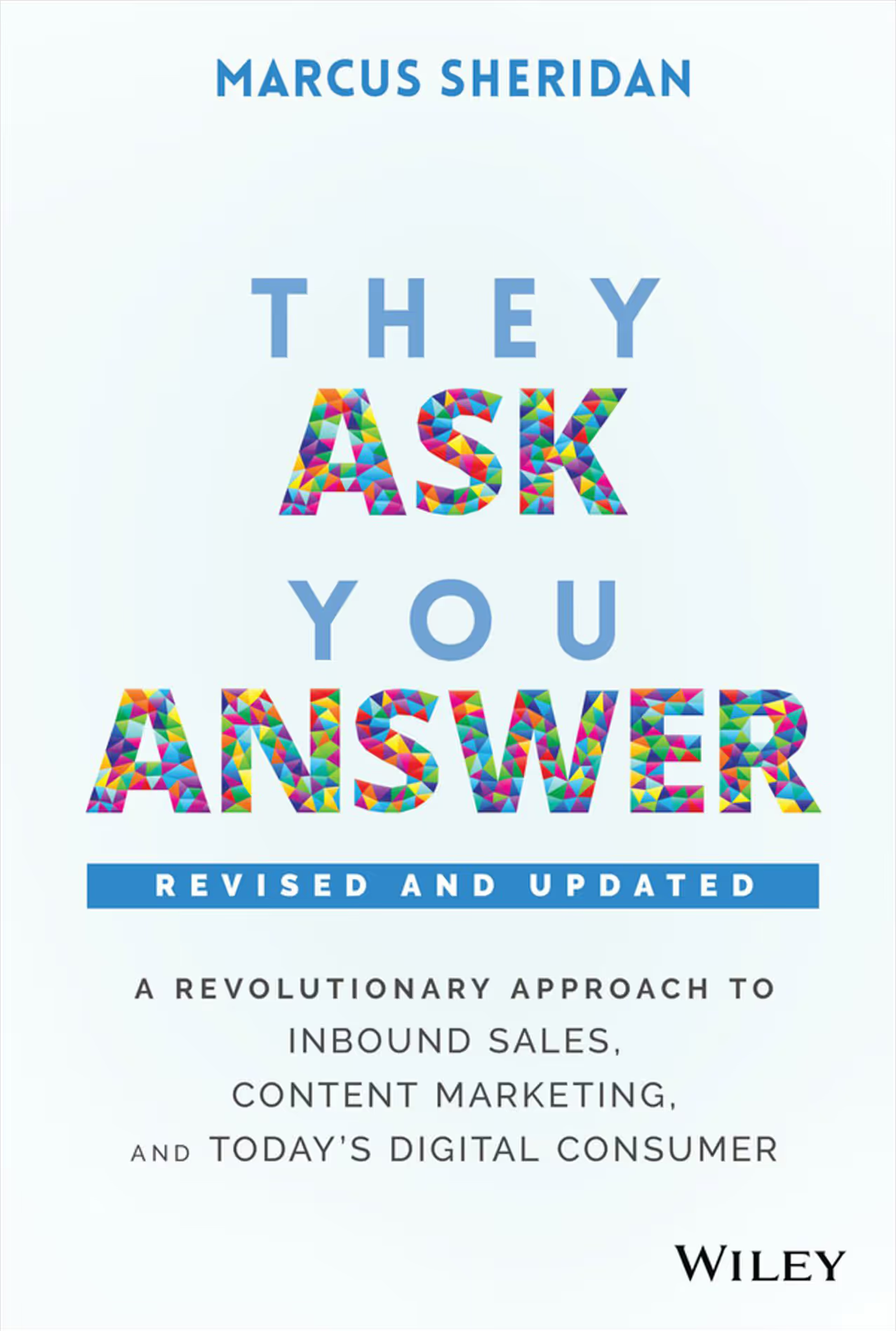Marcus Sheridan
They Ask You Answer
There’s an old saying that goes something like “if it sounds too good to be true, it probably is.” However sometimes the solutions to our greatest problems in business are far more simple than we imagine. Author Marcus Sheridan describes his own struggling pursuits in running a pool installation business when the housing market crashed in 2008. On the verge of bankruptcy, Marcus discovered inbound marketing and took to his keyboard in an attempt to distinguish his business from the competition. He did what everyone else in his industry was afraid to do:
Answer customer's questions.
Many businesses are stuck in very old ways of thinking about how sales happen. They Ask You Answer details the way cultural attitudes have changed and typical sales strategies are becoming less and less effective. Marketing now sells way more than direct sales efforts. Crazy to think about, but it’s true. Most people now make buying decisions before they talk to a single person.
Armed with this knowledge, the author began compiling all the common questions he already found himself answering day in and day out and created detailed blog posts answering those very inquiries. Most importantly of all, he tackled the questions that everyone else wouldn’t touch. He didn’t shy away from openly explaining pricing. People often scoff at this idea because pricing is either super variable, or because they’re afraid that prices will startle potential clients, sending them to competitors who might offer less expensive items or services.
First: For the variable pricing hang-up, that’s something that most shoppers will expect to be true, so take the time to explain the variables that are involved. The differing services and scopes of work involved in what your business offers, or how certain parts are chosen over others. The more information you can offer, the better. Consumers see this transparency as directly equal to trustworthiness. Many people won’t even bother contacting other service providers if your business is the only one around who’s forthcoming about costs.
Second: It may be completely true that your products and services are more costly than competitors, but that isn’t a bad thing. You’re more expensive for a reason, and you need to let hopeful clients know why that is. Is what you’re offering higher quality? Does it last longer? Is it made locally as opposed to overseas? Does your product do something unique that others can’t match? Tell people all about it. Maybe a cheap alternative is going to be just fine for some people, but your honesty in being willing to discuss costs plus your enthusiasm for explaining the value your business brings will cause people to more closely evaluate their needs. Are they really willing to repair the damages from a sloppily installed swimming pool? How much will it cost them in upkeep to maintain a lower quality product? Find what makes your company special and shout it from the rooftops. They Ask You Answer explains many other key facets of inbound marketing in terms that are easy to understand for an absolute beginner venturing into the world of self-promotion. All small business owners can find great value in learning how to answer questions, improve search engine rankings, and draw people in for free or very little cost.
Particularly helpful is Marcus Sheridan's discovery of what he calls, "The Big Five" content themes that are responsible for driving traffic.
Pricing and cost
“How much does _____ cost?”
Think about the last time you tried to find the pricing for something online, and you couldn’t find any. It’s frustrating, right? It doesn’t matter if what you sell is highly customized, if you’re worried about your competitors knowing what you’re charging, or scaring away potential prospects — you can and must talk about pricing.
Problems
“What are the negative issues or problems with _____?”
You need to address their problems and your problems. “Their” problems refers to problems your buyers may be experiencing. “Your” problems refers to problems with the solutions you offer.
Comparisons
“How does it compare to that other _______ that we’re looking at?”
When potential buyers are at the point where they’re evaluating solutions, they will actively seek out content that provides head-to-head comparisons between their choices.
Reviews
“What is everyone saying about ______?”
As buyers are considering making a purchase, they want to know how others feel about the purchases they made. If real people are raving about the purchase, they're more likely to buy. If others are complaining about the purchase, they may avoid it. If you can write honest reviews of the products you sell (and even don't sell), you'll connect with more prospects looking for help making purchases.
Best in class
“And what is the best _____?”
Think about the last time you made a big purchase and researched it beforehand online. Did you use words like best or top as part of your search terms? Most likely, right? We want to put all our options on a spectrum from worst to best and carefully review those on the far right of the spectrum. That’s why “best of” list content is so powerful.
The Explore blog section of Trig has been directly influenced by They Ask You Answer. Some of our highest performing blog posts are directly inspired by the Big 5:
How Much Does it Cost to Launch a Product to Market?
What is the Difference Between Qualitative and Quantitative Research?
Snag a copy from these retailers:

